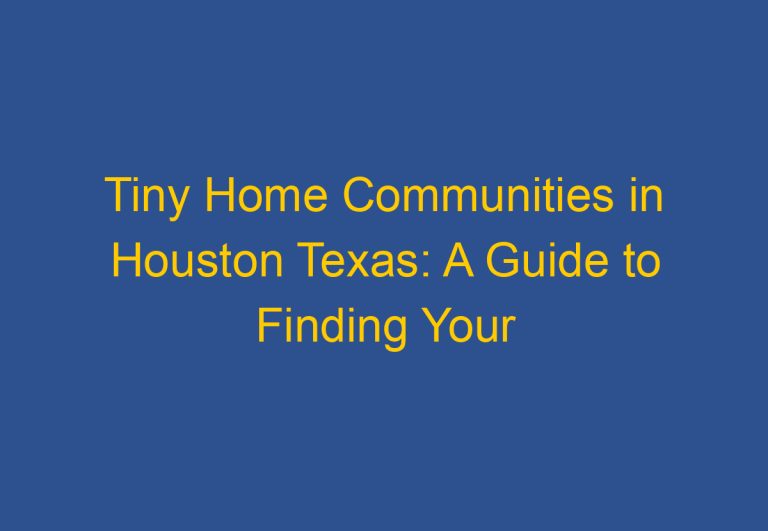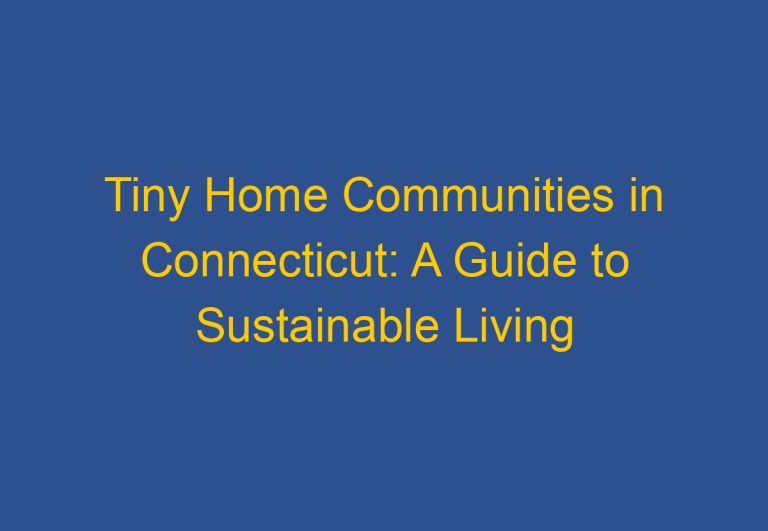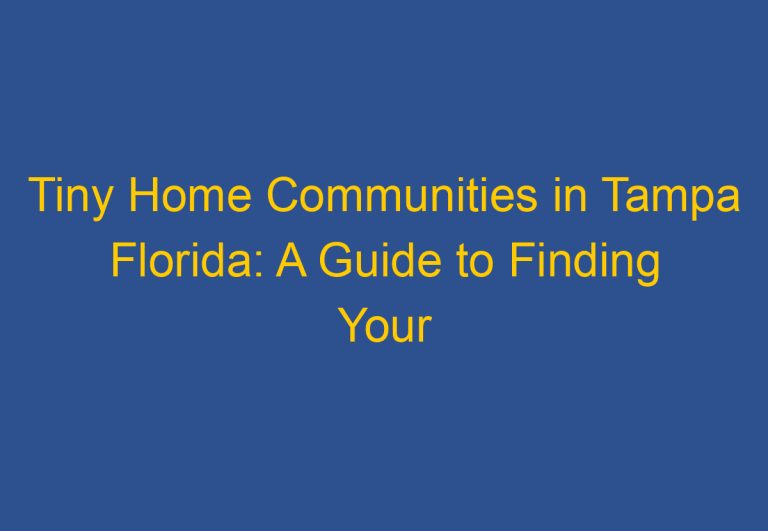Tiny Home Communities in CT: A Guide to Finding Your Ideal Community
Connecticut has become increasingly popular for its tiny home communities, offering residents an opportunity to live in a more sustainable and affordable way. These communities provide a unique living experience, with amenities such as shared outdoor spaces, communal gardens, and a strong sense of community.
Tiny home communities in Connecticut come in various forms, from mobile home parks that allow movable tiny homes to RV parks that welcome movable tiny houses for seasonal or extended stays. Local zoning regulations determine what types of structures are allowed in a given area, so it’s important to research the regulations in the particular town or city where the tiny house is located.
Despite their small size, tiny homes offer all the modern conveniences and are perfect for those who are living a single life wanting to escape the city or even as a first home for small families. If you’re thinking of ditching city living and taking a small slice of paradise in the “Nutmeg State,” you might want to consider a tiny home community.
Understanding Tiny Home Communities in CT
Tiny home living is becoming increasingly popular in Connecticut as people seek to downsize and reduce their environmental footprint. Tiny homes are typically less than 400 square feet and offer a minimalist lifestyle that emphasizes community and sustainability.
Tiny home communities in Connecticut are designed to provide a sense of community and shared experiences among residents. These communities often feature shared outdoor spaces, community gardens, and other amenities that promote a sense of belonging and connection.
One such community is the Tiny House Village in South Windsor, Connecticut. This community consists of tiny homes ranging in size from 200 to 400 square feet and features a clubhouse and a variety of amenities, including a community garden and shared outdoor space. Residents of this community enjoy a close-knit and supportive environment that fosters a sense of community and belonging.
Living in a tiny home community in Connecticut offers many benefits beyond just downsizing and reducing one’s environmental footprint. It provides an opportunity to live a more intentional and mindful lifestyle that emphasizes community, sustainability, and shared experiences.
Overall, tiny home communities in Connecticut offer a unique and rewarding lifestyle that is perfect for those looking to downsize and simplify their lives while also fostering a sense of community and connection with others.
Legal Aspects of Tiny Homes in Connecticut
Building Codes and Zoning
In Connecticut, the legality of tiny homes on foundations depends on local zoning regulations. Local zoning codes determine what types of structures are allowed in a given area. Some areas may allow tiny homes as accessory dwelling units (ADUs), while others may have restrictions or prohibitions.
Connecticut is considering updating its building codes to the 2018 International Residential Code (IRC), with consideration underway to adopt Appendix Q into statewide codes. Changes are now in the Public Comment Period and not expected to be considered until 2020.
RVIA Certification and DMV Requirements
If a tiny home is built on a trailer, it may be considered an RV or recreational vehicle. In this case, the tiny home must comply with the Recreational Vehicle Industry Association (RVIA) certification requirements and Department of Motor Vehicles (DMV) requirements.
It is important to note that not all tiny homes on trailers are considered RVs. If a tiny home on a trailer is designed to be a permanent residence and is not intended to be moved frequently, it may be considered a manufactured home and subject to different regulations.
In summary, the legality of tiny homes in Connecticut depends on local zoning codes and regulations of the specific municipality. Building codes and DMV requirements may also apply, depending on the type of tiny home. It is essential to research the zoning ordinances and regulations in your desired location and consult with local authorities before building a tiny home in Connecticut.
Key Locations for Tiny Home Enthusiasts
If you’re a tiny home enthusiast in Connecticut, you’ll be happy to know that there are several key locations in the state that are perfect for tiny living. These locations offer a unique living experience with amenities such as shared outdoor spaces and communal gardens.
Hartford and New Haven
Hartford and New Haven are two of the most popular locations for tiny home communities in Connecticut. These cities offer a vibrant urban lifestyle with easy access to all the amenities you need. The Nutmeg State is home to several tiny home builders, making it easy to find the perfect tiny home for your needs.
New London and Middletown
New London and Middletown are two other locations that are perfect for tiny home enthusiasts. These cities offer a more laid-back lifestyle with plenty of outdoor activities to enjoy. If you’re looking for a tiny home community that is close to nature, these locations are perfect for you.
East Hartford and Bridgeport
East Hartford and Bridgeport are two other locations that are worth considering if you’re a tiny home enthusiast. These cities offer a mix of urban and suburban living, making it easy to find a tiny home community that fits your lifestyle. With several tiny home builders in the area, you’ll have plenty of options to choose from.
Overall, Connecticut is a great state for tiny home enthusiasts. With several key locations to choose from, you’re sure to find a tiny home community that fits your needs and lifestyle. Whether you’re looking for an urban or more laid-back lifestyle, Connecticut has something to offer everyone.
Amenities and Lifestyle in Tiny Home Communities
Tiny home communities in Connecticut offer unique amenities and a simple lifestyle that is perfect for those looking to downsize. These communities feature a range of amenities that cater to the needs of the residents.
Design and Space Efficiency
The design of tiny homes is focused on space efficiency. The homes are designed to maximize the use of space and minimize waste. The use of lofts and windows with skylights allows for natural light to enter the home, making it feel more spacious. The homes are also designed to be energy-efficient, which means residents can save money on their utility bills.
Community Features and Shared Spaces
Tiny home communities in Connecticut are built around the concept of collaboration and mutual support. The communities encourage interaction and communal living, fostering strong bonds among residents. Community features such as a clubhouse, community garden, and shared outdoor space provide residents with a place to socialize and connect with others.
These communities are perfect for families looking for a simpler life. Tiny homes with 2 bedrooms and 1 bath are available, providing ample space for families to live comfortably. The shared spaces and amenities create a sense of community, making it easier for families to connect with others who share similar values and lifestyles.
In conclusion, tiny home communities in Connecticut offer a unique lifestyle that is perfect for those looking to downsize and simplify their lives. The amenities and community features provide residents with a sense of belonging, making it easier to connect with others who share similar values.
Frequently Asked Questions
What are the top-rated tiny home communities in Connecticut?
Connecticut has several top-rated tiny home communities, including Tiny Estates in Manchester, Green Valley Sustainable Village in Lebanon, and Rustic Tiny House Retreat in Voluntown. These communities offer a range of amenities, including clubhouses, outdoor activities, and affordable living spaces.
Are there any luxury tiny home communities in Connecticut?
Yes, there are luxury tiny home communities in Connecticut, such as Lake Tiny House Community in East Hampton. These communities offer high-end amenities, including swimming pools, fitness centers, and spa services.
How can one find affordable tiny home communities in Connecticut?
To find affordable tiny home communities in Connecticut, it is recommended to search online for communities that offer low-cost living spaces. Additionally, one can reach out to local real estate agents or tiny home builders to find out about affordable options.
What are the options for tiny home communities in Connecticut that offer homes for sale?
There are several options for tiny home communities in Connecticut that offer homes for sale, including Tiny Estates and Tiny House Village in East Lyme. These communities offer a range of homes for sale, from DIY tiny homes to luxury models.
Can you rent in tiny home communities in Connecticut, and if so, where?
Yes, there are several tiny home communities in Connecticut that offer rental options, such as Tiny Estates and Green Valley Sustainable Village. These communities offer short-term and long-term rental options for those looking to experience tiny home living without committing to purchasing a home.
What are the legal requirements for living in a tiny home in Connecticut?
The legal requirements for living in a tiny home in Connecticut vary depending on the town or city where the tiny home is located. It is recommended to review local zoning laws and building codes to ensure compliance with regulations. Additionally, it is important to make sure the tiny home is built to code and has all necessary permits before moving in.












